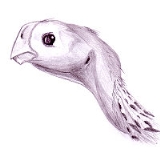
Ingenia
Encyclopedia
"Ingenia" is a genus
of oviraptorid
theropod dinosaur
s, with one known species
, "Ingenia" yanshini. Fossils have been found in several Late Cretaceous
-age formations (approximately 70 million years ago) of Mongolia
, most prominently in the Bugin Tsav beds of the Nemegt Formation
, which has also yielded the holotype
of Mononykus olecranus. "Ingenia" is known from only a few specimens, which include only the arms, legs, pelvis, shoulder girdle, and partial skull, and a few vertebrae. Some material referred to as "Ingenia" comes from older formations, but these specimens have not been well described.
.
.
, Ingenia mirabilis Gerlach, 1957, necessitating a replacement name, as mandated by the International Commission on Zoological Nomenclature
.
Genus
In biology, a genus is a low-level taxonomic rank used in the biological classification of living and fossil organisms, which is an example of definition by genus and differentia...
of oviraptorid
Oviraptoridae
Oviraptoridae is a group of bird-like, herbivorous and omnivorous maniraptoran dinosaurs. Oviraptorids are characterized by their toothless, parrot-like beaks and, in some cases, elaborate crests. They were generally small, measuring between one and two metres long in most cases, though some...
theropod dinosaur
Dinosaur
Dinosaurs are a diverse group of animals of the clade and superorder Dinosauria. They were the dominant terrestrial vertebrates for over 160 million years, from the late Triassic period until the end of the Cretaceous , when the Cretaceous–Paleogene extinction event led to the extinction of...
s, with one known species
Species
In biology, a species is one of the basic units of biological classification and a taxonomic rank. A species is often defined as a group of organisms capable of interbreeding and producing fertile offspring. While in many cases this definition is adequate, more precise or differing measures are...
, "Ingenia" yanshini. Fossils have been found in several Late Cretaceous
Late Cretaceous
The Late Cretaceous is the younger of two epochs into which the Cretaceous period is divided in the geologic timescale. Rock strata from this epoch form the Upper Cretaceous series...
-age formations (approximately 70 million years ago) of Mongolia
Mongolia
Mongolia is a landlocked country in East and Central Asia. It is bordered by Russia to the north and China to the south, east and west. Although Mongolia does not share a border with Kazakhstan, its western-most point is only from Kazakhstan's eastern tip. Ulan Bator, the capital and largest...
, most prominently in the Bugin Tsav beds of the Nemegt Formation
Nemegt Formation
The Nemegt Formation is a geological formation dating from the Late Cretaceous sedimentary from the Gobi Desert of Mongolia. It overlies and sometimes forms folds with the Barun Goyot Formation. It consists of river channel sediments and contains fossils of fish, turtles, crocodilians, birds and a...
, which has also yielded the holotype
Holotype
A holotype is a single physical example of an organism, known to have been used when the species was formally described. It is either the single such physical example or one of several such, but explicitly designated as the holotype...
of Mononykus olecranus. "Ingenia" is known from only a few specimens, which include only the arms, legs, pelvis, shoulder girdle, and partial skull, and a few vertebrae. Some material referred to as "Ingenia" comes from older formations, but these specimens have not been well described.
Etymology
The name "Ingenia" derives from the Ingen Khoboor Depression of Bayanhongor Aimak, Mongolia, from whence it was collected, while the specific name yanshini was chosen in honour of academician Aleksandr Leonidovich Yanshin (1911–1999), who was adviser and mentor to the describer Barbsold Rinchen during his time at the Paleontological Institute in St. Petersburg, RussiaRussia
Russia or , officially known as both Russia and the Russian Federation , is a country in northern Eurasia. It is a federal semi-presidential republic, comprising 83 federal subjects...
.
Taxonomy and phylogeny
"Ingenia" belongs to the oviraptorids, as distinguished by a pubis with a forward-curving shaft (among other features), and by the unique shape of the lower jaw with a strongly S-curved jaw margin, short snout, and rounded, fused cranial bones. Some material includes paired sternal plates fused along the midline and bearing a short carinaKeel
In boats and ships, keel can refer to either of two parts: a structural element, or a hydrodynamic element. These parts overlap. As the laying down of the keel is the initial step in construction of a ship, in British and American shipbuilding traditions the construction is dated from this event...
.
Name clash
The name Ingenia is currently occupied by that of a nematodeNematode
The nematodes or roundworms are the most diverse phylum of pseudocoelomates, and one of the most diverse of all animals. Nematode species are very difficult to distinguish; over 28,000 have been described, of which over 16,000 are parasitic. It has been estimated that the total number of nematode...
, Ingenia mirabilis Gerlach, 1957, necessitating a replacement name, as mandated by the International Commission on Zoological Nomenclature
International Commission on Zoological Nomenclature
The International Commission on Zoological Nomenclature is an organization dedicated to "achieving stability and sense in the scientific naming of animals". Founded in 1895, it currently comprises 28 members from 20 countries, mainly practicing zoological taxonomists...
.

